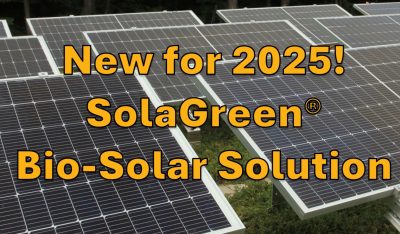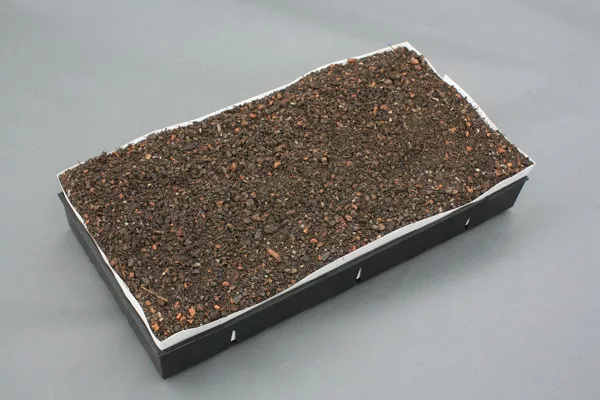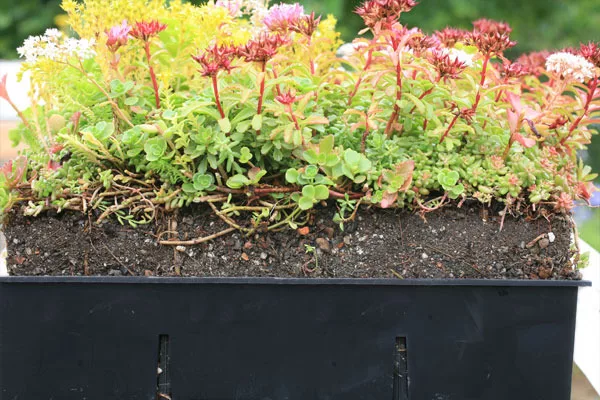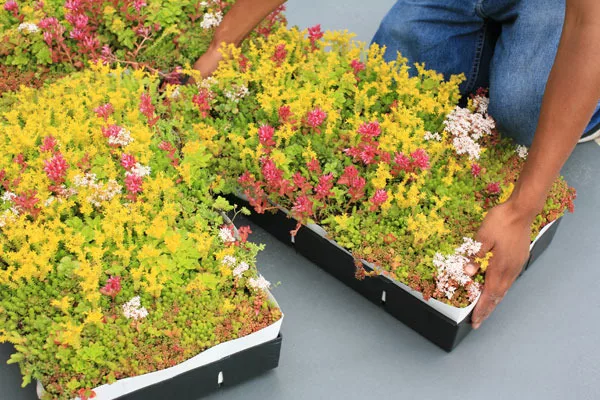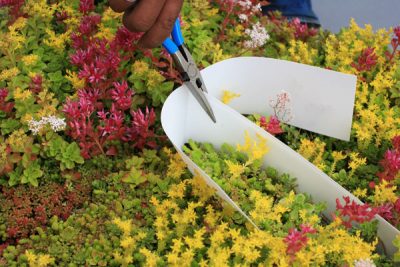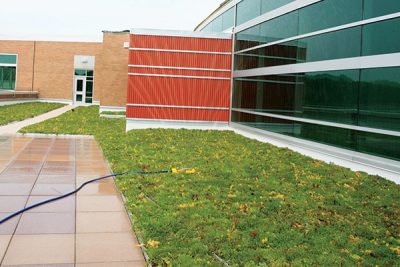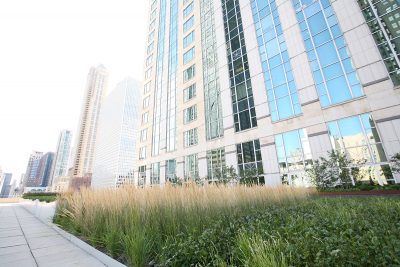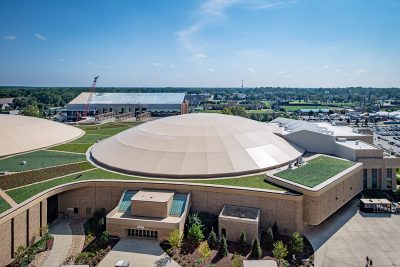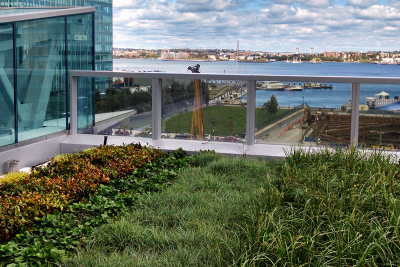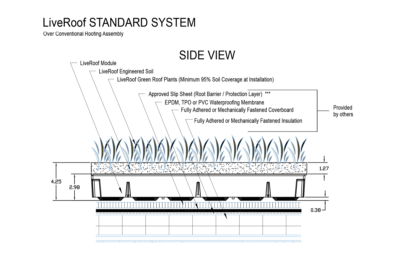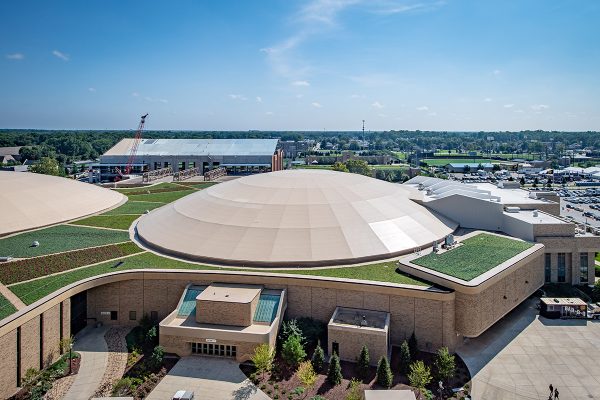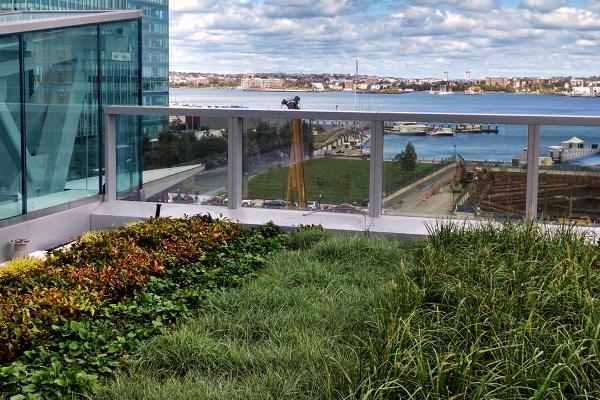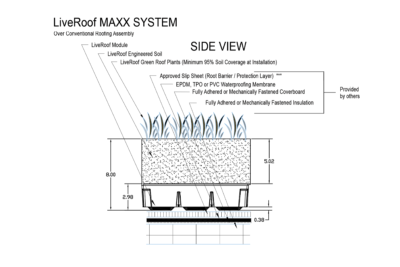Green Roof Modules
The LiveRoof system, patented in the United States and Canada, creates a seamless, beautiful and instantly mature green roof. The modules disappear under the cover of soil and plants which means no ugly container edges or grid lines.
Green Roof Modules
The LiveRoof system, patented in the United States and Canada, creates a seamless, beautiful and instantly mature green roof. The modules disappear under the cover of soil and plants which means no ugly container edges or grid lines.
Four Options for the Perfect Match
We offer the unique, patented LiveRoof hybrid green roof module in four soil depths to accommodate a broad array of green roof design objectives and climatic challenges. You can also download our System Properties sheet for all four modules.
How LiveRoof Works
LiveRoof Standard
WHAT IT IS.
The Standard System is the workhorse, used on 80% or more of LiveRoof projects. At 4.25 inches of soil, it is the popular choice for most new construction projects and many retrofits. With saturated weight of 27-29 lbs/sq ft, it is the perfect convergence of functional merits, cost and versatility.
WHAT IT DOES.
It provides exceptional storm water management, significant energy savings—even more if irrigated during the warm season. It is commonly used to meet green space requirements, provides modest biodiversity, supporting pollinators such as butterflies and honeybees, and will grow a palette of beautiful low maintenance plants—broad enough for both simple and relatively intricate designs. On top of this, the Standard System can seamlessly transition to the Deep and Maxx Systems without need for edging in between.
WHAT PLANTS WORK.
The type of plants used in the Standard System include a full array of low to tall growing sedums—from fine to very coarse-textured, green, yellow, blue, maroon and multi-colored. Flowers range from white, yellow, pink or purple. Alliums of all sizes are compatible and with regular irrigation a few a low-growing grasses such as little bluestem or prairie dropseed are possible, as are a few broad leaved non-succulent perennials.
HOW IT LOOKS.
Because Sedum plants range from fine- to very coarse-textured, and very short to quite tall, the look can vary according to the needs of the project. If one wants a fine-textured moss-like look it can be accomplished easily. But, course-textured and prairie-like are doable as well. Broad expanses are often planted, and more intricate patterns are done as well.
WHAT IT NEEDS.
With 4 ¼ inches of soil, the Standard System has pretty good water holding capacity, at least for succulent plants. But, when the summers are hot, it can dry down to the point where even Sedums need irrigation. And, given that climates everywhere are warming, we recommend irrigation as an inexpensive insurance policy—at least on moderate to large roofs. And, while many Standard Systems are installed without built-in irrigation, we are strong proponents of having a built-in irrigation system. It’s relatively inexpensive insurance and by watering occasionally, once per week with 1 inch of water, you can keep your plants thick and lush even through drought and heat—this makes maintenance easy and it looks nice. What’s more, if you keep some moisture in the soil, you will optimize evaporative cooling and save substantially on cooling costs. In any geographic area that has access to irrigation water, this is a win-win scenario, in respect to energy and resource savings.
Other than that, soil fertility should be managed attentively; typically one application of high quality sulfur coated fertilizer each spring is sufficient. LiveRoof’s Smart Weeding™ method should be followed regardless of geography (this is where the maintenance person takes a short “weed walk” every two weeks during the growing season—thus preventing the few baby weeds from growing up and having offspring).
HOW IT’S GROWN.
The base succulent plants are usually started from an assortment of cuttings that are mixed together, applied to the soil surface, and grown to maturity in the nursery setting. Occasionally, particularly if the designer is looking for something unique, the plant palette can be started from a combination of Sedum cuttings and plugs. Accent plants are typically planted from plugs or divisions.
In any event, each Standard System project is delivered fully grown (a process that typically takes 8 to 12 weeks depending upon climate and plant selections).
COMPARATIVE COST.
The Standard System is economical and will vary somewhat with the plant selections. It usually grows quickly, and installs very easily and quickly as well.
LiveRoof Deep
WHAT IT IS.
The Deep System is used for biodiverse green roofs. With 6 inch soil depth it becomes possible to support a broad array of non-succulent plants. One can literally create a prairie or shade garden on the roof. Naturally the weight is greater, appx. 40-50 pounds per square foot, depending upon soil and plants, but the weight is not so heavy as to greatly drive up the cost of the supporting structure.
WHAT IT DOES.
It is primarily used for biodiversity, prairies and garden-like perennial plantings. It also allows for food growing and shade planting, on roofs that are too shady for succulent plants. The Deep System is excellent for saving energy, good for storm water management, and easily meets most green space requirements.
Because it can support a broad array of plants, it can provide habitat and food for pollinators such as butterflies and honeybees and various bird species. Plantings can be random and naturalistic as well as patterned. The Deep System also seamlessly transitions to the Standard or Maxx System without need for edging in between.
WHAT PLANTS WORK.
The type of plants used in the Deep System include a full array of low to tall growing Sedums, hundreds of different fibrous rooted herbaceous perennials, including native forbs, sedges, grasses and edible plants. But, one should avoid plants with woody root systems such as shrubs, as they can damage waterproofing. Foliage colors can vary widely; green, yellow, red, purple and blue are possible, and flowers of any color and shape are found within the broad palette of plants capable of growing in its 6 inch soil profile.
HOW IT LOOKS.
Its appearance is determined by plant selection, and often the plants are arranged in naturalistic sweeps or planted randomly when creating prairie habitat. And, because roofs are often windy, grasses are commonly employed for an added element of motion.
WHAT IT NEEDS.
You might think that with 6 inches of soil, the Deep System would have tremendous water holding capacity, and it does. However, the plants that are used are typically not the type that store water, like the succulents used in the thinner soil profiles. Therefore, whenever the Deep System is used, one must include a built-in spray rotor irrigation system in the design. Spray rotor heads should be used, as (in the gravelly soils used for green roofs) they use considerably less water than drip or sub irrigation methods. Irrigation frequency will vary with climate and plant types, but in general it will need irrigation every 3 or 4 days during the summer months.
Maintenance is more involved than with the other systems, but less than traditional landscape plantings as LiveRoof soil is not full of weed seeds like typical topsoil.
HOW IT’S GROWN.
Many designers prefer to include a base layer of succulent Sedums, as a living mulch, in conjunction with the core accent plants, which are planted from plugs and grown on at the nursery until well-rooted.
It is important to provide plenty of advance notice to your LiveRoof grower if any uncommon species or quantities are needed. Grow time ranges from approximately 10 to 16 weeks depending upon climate and plant selections.
COMPARATIVE COST.
The Deep System is more costly than the Standard System because of the soil depth, plant types, and relatively longer installation time. But, like the other systems it is a remarkable investment that pays off with energy savings, extension of the roof life, beauty, code compliance, quality of life, and so much more.
LiveRoof Lite
WHAT IT IS.
The Lite System is typically used on retrofit projects when the roof is engineered with only 15 to 17 pounds per sf for the green roof component. Its soil depth is a full 2 ½ inches, enough to support many low growing succulents and a limited number of accent plants. It is generally not recommended for hot climates.
WHAT IT DOES.
It provides a modest level of storm water management, modest energy savings—especially if attentively irrigated during the warm season. It also meets greenspace requirements in many instances, and provides limited biodiversity. Its plants will support pollinators such as butterflies and honeybees, and the plants that grow in the Lite System are diverse enough to support patterned designs.
WHAT PLANTS WORK.
The plants used in the Lite System include a fairly broad range of low growing Sedums—mostly fine- and medium-textured, as well as a few Alliums, for vertical and textural interest.
HOW IT LOOKS.
Because the Sedum plants used with this system are fine to medium-textured and relatively low growing, designs can vary from moss-like to medium-textured (similar to a lawn). Foliage colors can vary from green, to yellow, red and blue, and flowers from white, yellow, and pink to reddish. Various low growing (6″-10″ tall) Alliums can be used for accent and they typically have green or bluish foliage and flowers of white, pink or purple.
WHAT IT NEEDS.
Because the Lite System has only 2 ½ inches of soil, it will dry out regularly during summer. Therefore, we strongly recommend a built-in irrigation system. During typical summertime weather, it should be watered once per week, usually for 25-30 minutes (about 1 inch of water).
Soil fertility should be managed attentively; typically one application of a high quality sulfur-coated fertilizer each spring is adequate. LiveRoof’s Smart Weeding™ method should be followed (where the maintenance person takes a short “weed walk” every two weeks during the growing season—thus preventing a few baby weeds from growing up and having offspring).
HOW IT’S GROWN.
The base succulent plants (typically Sedums) are usually started from cuttings that are blended, applied to the soil surface, and grown to maturity in the nursery setting. Occasionally, particularly if the designer is looking for something unique, it can be started from a combination of Sedum plugs and cuttings. Accent plants, such as Allium, are planted from plugs or divisions as well. When mature, a process that typically takes 8 to 12 weeks depending upon climate, it is delivered to the project site and installed on the roof.
COMPARATIVE COST.
The Lite System is economical; it utilizes relatively inexpensive plants, is grown quickly and is fast and easy to install.
LiveRoof Maxx
WHAT IT IS.
The Maxx System is a niche product for unique needs—such as for vegetable gardening on decks and balconies where access may require carrying the modules up a flight of stairs. There are also a few municipalities that require an 8 inch soil depth for water retention code—which is odd as research indicates that a thinner depth, e.g. 4 inches, is better as it tends to dry down more between storm events.
No matter the application, it can be used just like the Deep System to create a biodiverse prairie, sun or shade gardens, and vegetable gardens. Naturally the weight is significant at 60-65 pounds per sf., but usually the installations are small and there is often ample structural capacity on the type of roofs where it is used.
WHAT IT DOES.
It is primarily used for small scale vegetable gardens or for patches of tall accent plants, such as grasses, in conjunction with the Standard System.
WHAT PLANTS WORK.
The type of plants used in the Maxx System include most popular edible plants including herbs, peppers and tomatoes, kale, beans, carrots, cabbage, even sweet corn. Naturally, it will also support a full array of low to tall growing Sedums, hundreds of different fibrous rooted herbaceous perennials (including native forbes, sedges and grasses). But, one should avoid woody plants, such as shrubs, that have woody root systems which might damage waterproofing membranes.
HOW IT LOOKS.
It is usually planted with rows of vegetables and herbs. It can, of course, also be used to create beautiful flower gardens and prairie habitat. Foliage colors span green, yellow, red, purple and blue, and variegated, and flowers of any color and shape are found within the broad palette of plants capable of growing in its 8 inch soil profile.
WHAT IT NEEDS.
An automatic irrigation system, with spray rotor heads is recommended. For small residential applications, a hose and spigot, with a battery operated controller, can suffice.
Maintenance is similar to typical garden maintenance, but with much less weed pressure as LiveRoof engineered soil is not full of weed seeds like typical topsoil.
HOW IT’S GROWN.
At times the Maxx System is filled with soil and delivered with no plants—so the property owner can plant it with edibles. When used for perennial plants, it is almost always plug-planted, grown (at the nursery) until well rooted, then delivered to the job site.
It is important to provide plenty of advance notice if any uncommon species or quantities are needed. Grow time ranges from 8 to 16 weeks depending upon climate and plant selections.
COMPARATIVE COST.
The Maxx System is more costly than the other LiveRoof systems because of the soil depth, smaller footprint, plant types, and relatively longer installation time. But, for its intended purpose, it is often a very economical alternative.
*Soil dry weights may vary regionally depending upon the locally sourced aggregates. Confirm dry weights with local LiveRoof Licensed Grower.

